2017 RENAULT ALASKAN warning
[x] Cancel search: warningPage 24 of 340

WARNING
• Never allow anyone to ride on the rear seats
when they are in the fold-up position. Use of
this area by passengers without proper re-
straints could result in serious injury or death
in an accident or sudden stop.
• When folding or returning the rear seat, be
careful not to squeeze your finger between
the seat cushion and the body side.
JUMP SEATS (where fitted for King Cab
models) WARNING
• Do not use the jump seats for child restraint
installation.
• When folding or returning the jump seat, be
careful not to squeeze your finger between
the seat cushion and the body side. •
Jump seats are designed as temporary seats
only and should only be used on occasional
short distance travels. WARNING
Head restraints supplement the other vehicle
safety systems. They may provide additional pro-
tection against injury in certain rear end colli-
sions. Adjustable head restraints must be ad-
justed properly, as specified in this section. Check the adjustment after someone else uses
the seat. Do not attach anything to the head re-
straint stalks or remove the head restraint. Do
not use the seat if the head restraint has been
removed. If the head restraint was removed, re-
install and properly adjust the head restraint be-
fore an occupant uses the seating position. Fail-
ure to follow these instructions can reduce the
effectiveness of the head restraint. This may in-
crease the risk of serious injury or death in acol-
lision.
• Your vehicle is equipped with
ahead restraint
that may be integrated, adjustable or non-adjust-
able.
• Adjustable head restraints have multiple notches
along the stalk to lock them in
adesired adjust-
ment position.
• The non-adjustable head restraints have
asingle
locking notch to secure them to the seat frame.
• Proper Adjustment:
–F
or the adjustable type, align the head re-
straint so the centre of your ear is approxi-
mately level with the centre of the head re-
straint. NIC2817 HEAD RESTRAINTS
1-6 Safety —seats, seat belts and supplemental restraint system
Page 28 of 340
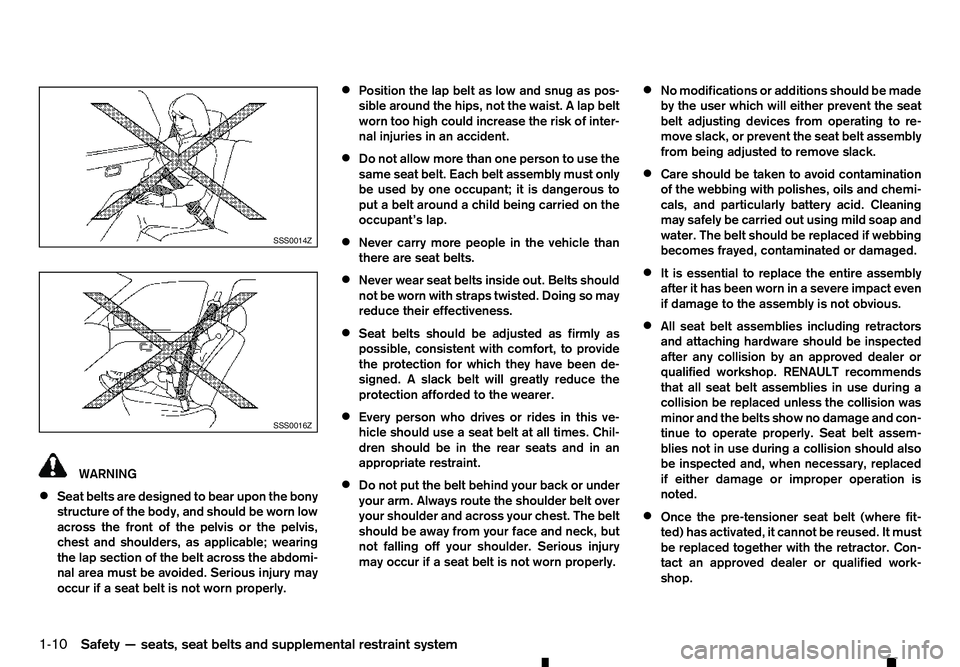
WARNING
• Seat belts are designed to bear upon the bony
structure of the body, and should be worn low
across the front of the pelvis or the pelvis,
chest and shoulders, as applicable; wearing
the lap section of the belt across the abdomi-
nal area must be avoided. Serious injury may
occur if aseat belt is not worn properly. •
Position the lap belt as low and snug as pos-
sible around the hips, not the waist.
Alap belt
worn too high could increase the risk of inter-
nal injuries in an accident.
• Do not allow more than one person to use the
same seat belt. Each belt assembly must only
be used by one occupant; it is dangerous to
put
abelt around achild being carried on the
occupant’s lap.
• Never carry more people in the vehicle than
there are seat belts.
• Never wear seat belts inside out. Belts should
not be worn with straps twisted. Doing so may
reduce their effectiveness.
• Seat belts should be adjusted as firmly as
possible, consistent with comfort, to provide
the protection for which they have been de-
signed.
Aslack belt will greatly reduce the
protection afforded to the wearer.
• Every person who drives or rides in this ve-
hicle should use
aseat belt at all times. Chil-
dren should be in the rear seats and in an
appropriate restraint.
• Do not put the belt behind your back or under
your arm. Always route the shoulder belt over
your shoulder and across your chest. The belt
should be away from your face and neck, but
not falling off your shoulder. Serious injury
may occur if aseat belt is not worn properly. •
No modifications or additions should be made
by the user which will either prevent the seat
belt adjusting devices from operating to re-
move slack, or prevent the seat belt assembly
from being adjusted to remove slack.
• Care should be taken to avoid contamination
of the webbing with polishes, oils and chemi-
cals, and particularly battery acid. Cleaning
may safely be carried out using mild soap and
water. The belt should be replaced if webbing
becomes frayed, contaminated or damaged.
• It is essential to replace the entire assembly
after it has been worn in
asevere impact even
if damage to the assembly is not obvious.
• All seat belt assemblies including retractors
and attaching hardware should be inspected
after any collision by an approved dealer or
qualified workshop. RENAULT recommends
that all seat belt assemblies in use during a
collision be replaced unless the collision was
minor and the belts show no damage and con-
tinue to operate properly. Seat belt assem-
blies not in use during
acollision should also
be inspected and, when necessary, replaced
if either damage or improper operation is
noted.
• Once the pre-tensioner seat belt (where fit-
ted) has activated, it cannot be reused. It must
be replaced together with the retractor. Con-
tact an approved dealer or qualified work-
shop. SSS0014Z
SSS0016Z
1-10 Safety —seats, seat belts and supplemental restraint system
Page 29 of 340
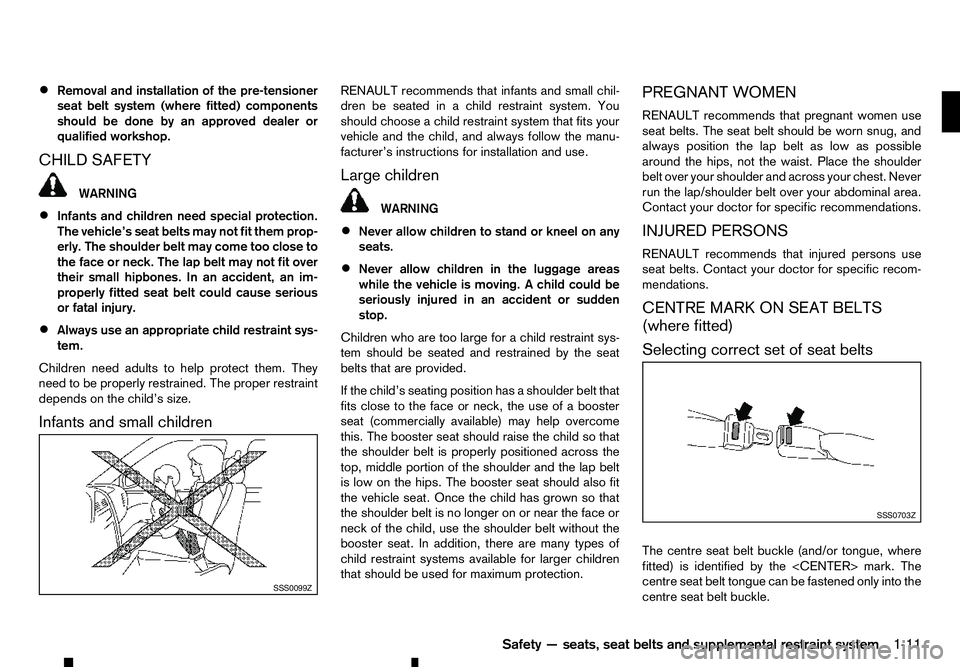
•
Removal and installation of the pre-tensioner
seat belt system (where fitted) components
should be done by an approved dealer or
qualified workshop.
CHILD SAFETY WARNING
• Infants and children need special protection.
The vehicle’s seat belts may not fit them prop- erly. The shoulder belt may come too close to
the face or neck. The lap belt may not fit over
their small hipbones. In an accident, an im-
properly fitted seat belt could cause serious
or fatal injury.
• Always use an appropriate child restraint sys-
tem.
Children need adults to help protect them. They
need to be properly restrained. The proper restraint
depends on the child’s size.
Infants and small children RENAULT recommends that infants and small chil-
dren be seated in
achild restraint system. You
should choose achild restraint system that fits your
vehicle and the child, and always follow the manu-
facturer’s instructions for installation and use.
Large children WARNING
• Never allow children to stand or kneel on any
seats.
• Never allow children in the luggage areas
while the vehicle is moving.
Achild could be
seriously injured in an accident or sudden
stop.
Children who are too large for achild restraint sys-
tem should be seated and restrained by the seat
belts that are provided.
If the child’s seating position has ashoulder belt that
fits close to the face or neck, the use of abooster
seat (commercially available) may help overcome
this. The booster seat should raise the child so that the shoulder belt is properly positioned across the
top, middle portion of the shoulder and the lap belt
is low on the hips. The booster seat should also fit
the vehicle seat. Once the child has grown so that
the shoulder belt is no longer on or near the face or
neck of the child, use the shoulder belt without the
booster seat. In addition, there are many types of
child restraint systems available for larger children
that should be used for maximum protection. PREGNANT WOMEN
RENAULT recommends that pregnant women use
seat belts. The seat belt should be worn snug, and
always position the lap belt as low as possible
around the hips, not the waist. Place the shoulder
belt over your shoulder and across your chest. Never
run the lap/shoulder belt over your abdominal area.
Contact your doctor for specific recommendations.
INJURED PERSONS
RENAULT recommends that injured persons use
seat belts. Contact your doctor for specific recom-
mendations.
CENTRE MARK ON SEAT BELTS
(where fitted)
Selecting correct set of seat belts
The centre seat belt buckle (and/or tongue, where
fitted) is identified by the
centre seat belt tongue can be fastened only into the
centre seat belt buckle.
SSS0099Z SSS0703Z
Safety —seats, seat belts and supplemental restraint system
1-11
Page 30 of 340
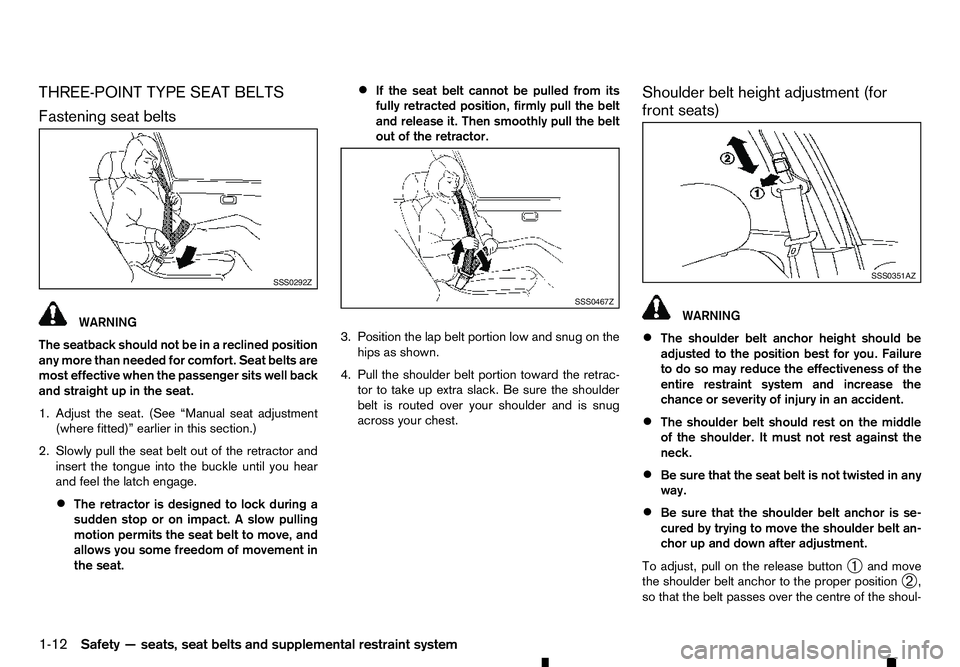
THREE-POINT TYPE SEAT BELTS
Fastening seat belts WARNING
The seatback should not be in
areclined position
any more than needed for comfort. Seat belts are
most effective when the passenger sits well back
and straight up in the seat.
1. Adjust the seat. (See “Manual seat adjustment
(where fitted)” earlier in this section.)
2. Slowly pull the seat belt out of the retractor and insert the tongue into the buckle until you hear
and feel the latch engage.
• The retractor is designed to lock during a
sudden stop or on impact.
Aslow pulling
motion permits the seat belt to move, and
allows you some freedom of movement in
the seat. •
If the seat belt cannot be pulled from its
fully retracted position, firmly pull the belt
and release it. Then smoothly pull the belt
out of the retractor.
3. Position the lap belt portion low and snug on the hips as shown.
4. Pull the shoulder belt portion toward the retrac- tor to take up extra slack. Be sure the shoulder
belt is routed over your shoulder and is snug
across your chest. Shoulder belt height adjustment (for
front seats) WARNING
• The shoulder belt anchor height should be
adjusted to the position best for you. Failure
to do so may reduce the effectiveness of the
entire restraint system and increase the
chance or severity of injury in an accident.
• The shoulder belt should rest on the middle
of the shoulder. It must not rest against the
neck.
• Be sure that the seat belt is not twisted in any
way.
• Be sure that the shoulder belt anchor is se-
cured by trying to move the shoulder belt an-
chor up and down after adjustment.
To adjust, pull on the release button ➀and move
the shoulder belt anchor to the proper position ➁,
so that the belt passes over the centre of the shoul- SSS0292Z
SSS0467Z SSS0351AZ
1-12 Safety —seats, seat belts and supplemental restraint system
Page 31 of 340
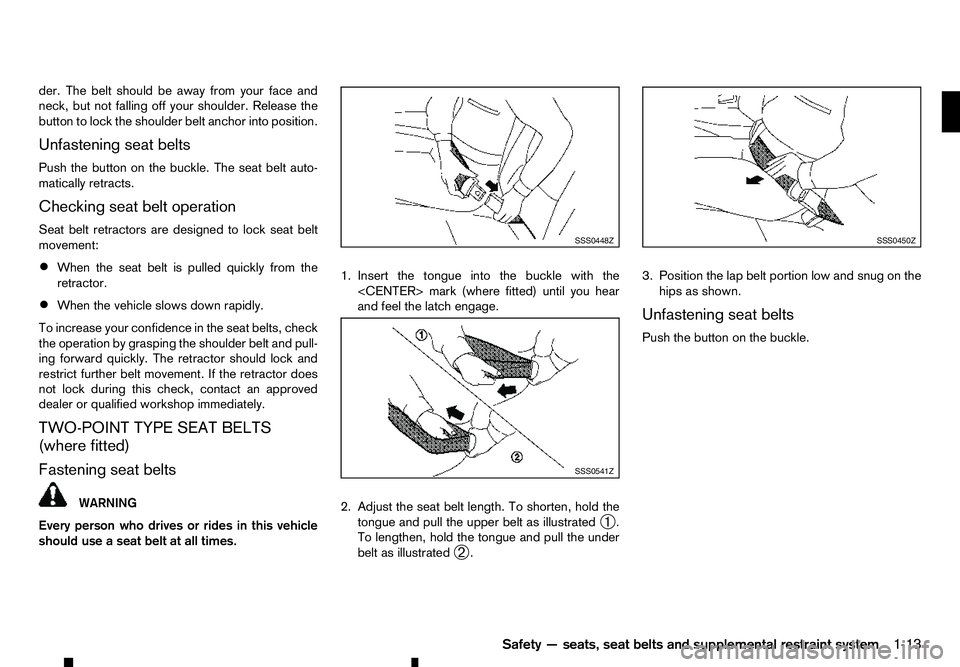
der. The belt should be away from your face and
neck, but not falling off your shoulder. Release the
button to lock the shoulder belt anchor into position.
Unfastening seat belts
Push the button on the buckle. The seat belt auto-
matically retracts.
Checking seat belt operation
Seat belt retractors are designed to lock seat belt
movement:
• When the seat belt is pulled quickly from the
retractor.
• When the vehicle slows down rapidly.
To increase your confidence in the seat belts, check
the operation by grasping the shoulder belt and pull-
ing forward quickly. The retractor should lock and
restrict further belt movement. If the retractor does
not lock during this check, contact an approved
dealer or qualified workshop immediately.
TWO-POINT TYPE SEAT BELTS (where fitted)
Fastening seat belts WARNING
Every person who drives or rides in this vehicle
should use aseat belt at all times. 1. Insert the tongue into the buckle with the
and feel the latch engage.
2. Adjust the seat belt length. To shorten, hold the tongue and pull the upper belt as illustrated ➀.
To lengthen, hold the tongue and pull the under
belt as illustrated ➁. 3. Position the lap belt portion low and snug on the
hips as shown.
Unfastening seat belts
Push the button on the buckle. SSS0448Z
SSS0541Z SSS0450Z
Safety —seats, seat belts and supplemental restraint system
1-13
Page 32 of 340
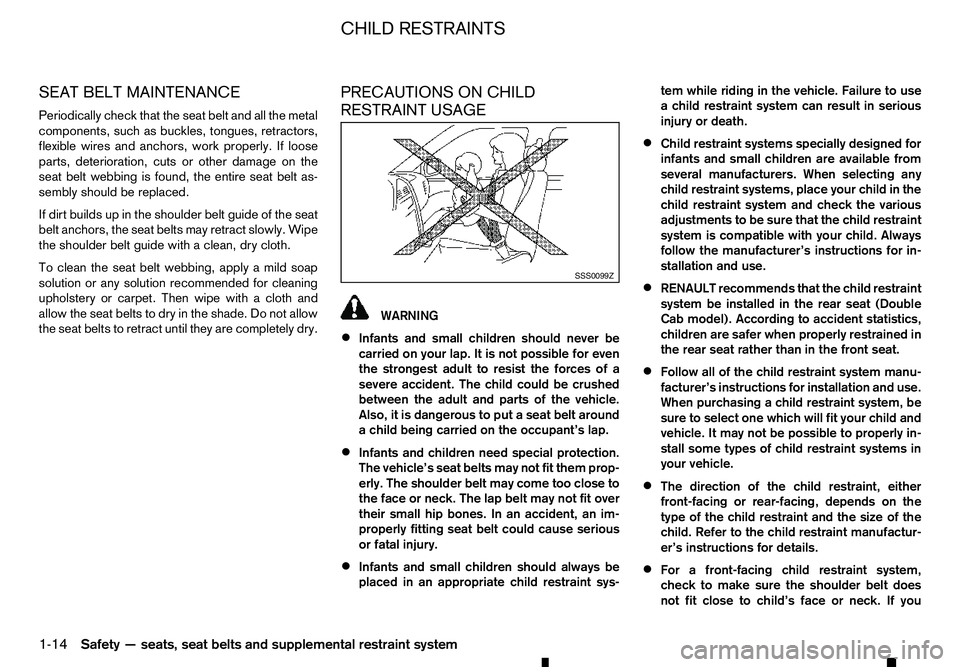
SEAT BELT MAINTENANCE
Periodically check that the seat belt and all the metal
components, such as buckles, tongues, retractors,
flexible wires and anchors, work properly. If loose
parts, deterioration, cuts or other damage on the
seat belt webbing is found, the entire seat belt as-
sembly should be replaced.
If dirt builds up in the shoulder belt guide of the seat
belt anchors, the seat belts may retract slowly. Wipe
the shoulder belt guide with aclean, dry cloth.
To clean the seat belt webbing, apply amild soap
solution or any solution recommended for cleaning
upholstery or carpet. Then wipe with acloth and
allow the seat belts to dry in the shade. Do not allow
the seat belts to retract until they are completely dry. PRECAUTIONS ON CHILD
RESTRAINT USAGE WARNING
• Infants and small children should never be
carried on your lap. It is not possible for even
the strongest adult to resist the forces of a
severe accident. The child could be crushed
between the adult and parts of the vehicle.
Also, it is dangerous to put aseat belt around
ac hild being carried on the occupant’s lap.
• Infants and children need special protection.
The vehicle’s seat belts may not fit them prop-
erly. The shoulder belt may come too close to
the face or neck. The lap belt may not fit over
their small hip bones. In an accident, an im-
properly fitting seat belt could cause serious
or fatal injury.
• Infants and small children should always be
placed in an appropriate child restraint sys- tem while riding in the vehicle. Failure to use
ac
hild restraint system can result in serious
injury or death.
• Child restraint systems specially designed for
infants and small children are available from
several manufacturers. When selecting any
child restraint systems, place your child in the
child restraint system and check the various
adjustments to be sure that the child restraint
system is compatible with your child. Always
follow the manufacturer’s instructions for in-
stallation and use.
• RENAULT recommends that the child restraint
system be installed in the rear seat (Double
Cab model). According to accident statistics,
children are safer when properly restrained in
the rear seat rather than in the front seat.
• Follow all of the child restraint system manu-
facturer’s instructions for installation and use.
When purchasing
achild restraint system, be
sure to select one which will fit your child and
vehicle. It may not be possible to properly in- stall some types of child restraint systems in
your vehicle.
• The direction of the child restraint, either
front-facing or rear-facing, depends on the
type of the child restraint and the size of the child. Refer to the child restraint manufactur-
er’s instructions for details.
• For
afront-facing child restraint system,
check to make sure the shoulder belt does
not fit close to child’s face or neck. If you SSS0099Z
CHILD RESTRAINTS
1-14 Safety —seats, seat belts and supplemental restraint system
Page 39 of 340
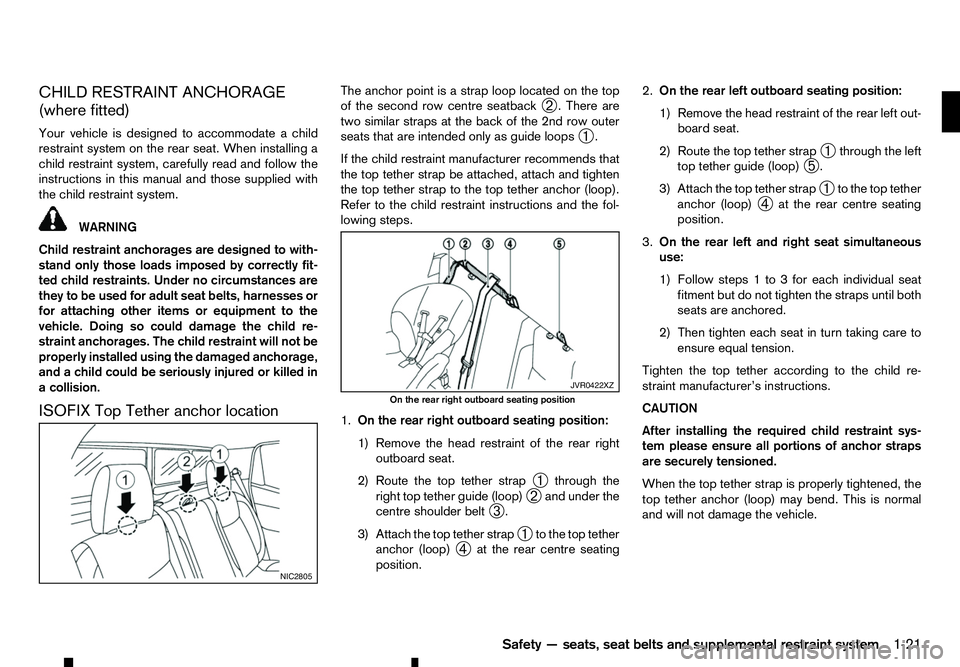
CHILD RESTRAINT ANCHORAGE
(where fitted)
Your vehicle is designed to accommodate achild
restraint system on the rear seat. When installing a
child restraint system, carefully read and follow the instructions in this manual and those supplied with
the child restraint system. WARNING
Child restraint anchorages are designed to with-
stand only those loads imposed by correctly fit-
ted child restraints. Under no circumstances are
they to be used for adult seat belts, harnesses or
for attaching other items or equipment to the
vehicle. Doing so could damage the child re-
straint anchorages. The child restraint will not be
properly installed using the damaged anchorage,
and achild could be seriously injured or killed in
ac ollision.
ISOFIX Top Tether anchor location The anchor point is
astrap loop located on the top
of the second row centre seatback ➁.T
here are
two similar straps at the back of the 2nd row outer
seats that are intended only as guide loops ➀.
If the child restraint manufacturer recommends that
the top tether strap be attached, attach and tighten
the top tether strap to the top tether anchor (loop).
Refer to the child restraint instructions and the fol-
lowing steps.
1. On the rear right outboard seating position:
1) Remove the head restraint of the rear right
outboard seat.
2) Route the top tether strap ➀through the
right top tether guide (loop) ➁and under the
centre shoulder belt ➂.
3) Attach the top tether strap ➀to the top tether
anchor (loop) ➃at the rear centre seating
position. 2.
On the rear left outboard seating position:
1) Remove the head restraint of the rear left out-
board seat.
2) Route the top tether strap ➀through the left
top tether guide (loop) ➄.
3) Attach the top tether strap ➀to the top tether
anchor (loop) ➃at the rear centre seating
position.
3. On the rear left and right seat simultaneous
use:
1) Follow steps 1to3for each individual seat
fitment but do not tighten the straps until both
seats are anchored.
2) Then tighten each seat in turn taking care to ensure equal tension.
Tighten the top tether according to the child re-
straint manufacturer’s instructions.
CAUTION
After installing the required child restraint sys-
tem please ensure all portions of anchor straps
are securely tensioned.
When the top tether strap is properly tightened, the
top tether anchor (loop) may bend. This is normal
and will not damage the vehicle. NIC2805 JVR0422XZ
On the rear right outboard seating position
Safety—seats, seat belts and supplemental restraint system 1-21
Page 40 of 340
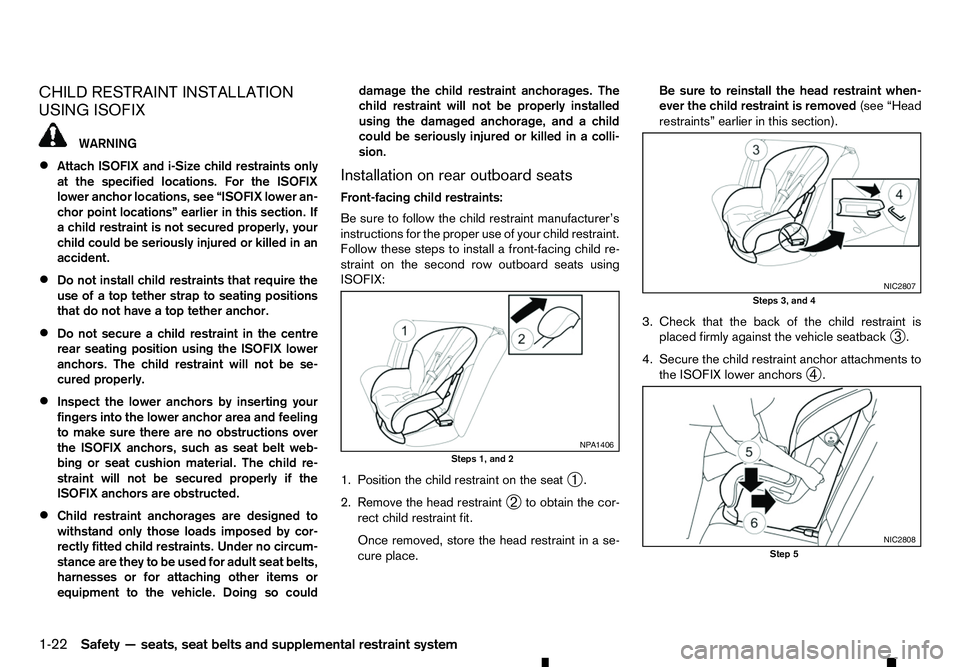
CHILD RESTRAINT INSTALLATION
USING ISOFIX WARNING
• Attach ISOFIX and i-Size child restraints only
at the specified locations. For the ISOFIX
lower anchor locations, see “ISOFIX lower an-
chor point locations” earlier in this section. If
ac hild restraint is not secured properly, your
child could be seriously injured or killed in an
accident.
• Do not install child restraints that require the
use of
atop tether strap to seating positions
that do not have atop tether anchor.
• Do not secure
achild restraint in the centre
rear seating position using the ISOFIX lower
anchors. The child restraint will not be se-
cured properly.
• Inspect the lower anchors by inserting your
fingers into the lower anchor area and feeling
to make sure there are no obstructions over the ISOFIX anchors, such as seat belt web-
bing or seat cushion material. The child re-
straint will not be secured properly if the
ISOFIX anchors are obstructed.
• Child restraint anchorages are designed to
withstand only those loads imposed by cor-
rectly fitted child restraints. Under no circum-
stance are they to be used for adult seat belts,
harnesses or for attaching other items or
equipment to the vehicle. Doing so could damage the child restraint anchorages. The
child restraint will not be properly installed
using the damaged anchorage, and
achild
could be seriously injured or killed in acolli-
sion.
Installation on rear outboard seats
Front-facing child restraints:
Be sure to follow the child restraint manufacturer’s
instructions for the proper use of your child restraint.
Follow these steps to install afront-facing child re-
straint on the second row outboard seats using
ISOFIX:
1. Position the child restraint on the seat ➀.
2. Remove the head restraint ➁to obtain the cor-
rect child restraint fit.
Once removed, store the head restraint in ase-
cure place. Be sure to reinstall the head restraint when-
ever the child restraint is removed
(see “Head
restraints” earlier in this section).
3. Check that the back of the child restraint is placed firmly against the vehicle seatback ➂.
4. Secure the child restraint anchor attachments to the ISOFIX lower anchors ➃. NP A1406
Steps 1, and 2 NIC2807
Steps 3, and 4
NIC2808
Step 5
1-22 Safety —seats, seat belts and supplemental restraint system